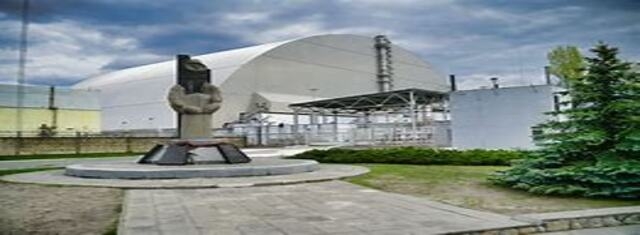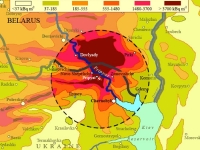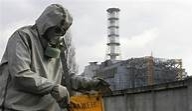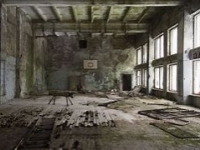News
Chernobyl – Then and Now
Keeping Nuclear Plant in Ukraine Safe

Chernobyl nuclear plant before invasion
USPA NEWS -
Retreating Russian troops laid landmines at the Chernobyl nuclear power plant as they departed after holding workers there captive for more than a month, a Ukrainian official has said. The danger for nuclear safety staff working at the site remains high due to the heightened risk of radiation and the potential for explosions caused by the landmines.
Maksym Shevchuk, deputy head of Ukraine’s State Agency for Exclusion Zone Management (DAZN) states: “Our sappers are now working on the de-mining of key locations and checking everything it is possible to check.” He added that “for now people are using only well-known routes and asphalt roads” in order to avoid any hidden mines. Valeriy Korshunov, founder of the European Institute of Chernobyl, a Ukraine-based NGO, has also mentioned that workers say spent nuclear fuel storage facility and other facilities within the exclusion zone “may be mined”. It has not been possible to independently verify his claims.
The Russians also left graffiti across the exclusion zone saying: “This passage is mined” and “expect a surprise, look for a mine”, according to footage collected by the Ukrainian Witness media group. The reports of landmines at Chernobyl concerns experts, who say it may have interfered with vital safety work that is normally ongoing at the nuclear plant. “The international community had taken steps for Chernobyl to be completely safe,” Claire Corkhill, professor in nuclear material degradation at the University of Sheffield, adding that the Russian invaders have now “messed up the whole plan we had for Chernobyl”.
(April 26, 1986)
The 1986 explosion in Chernobyl’s fourth reactor sent radioactive material into the air and across Europe. The Russian government said that only 31 people died as a result of the nuclear accident. That number died in the first few weeks from fatal doses of radiation. When in fact the total is closer to 90,000 who died in subsequent years from radiation-related diseases including cancer.
Today much of the radioactive material at Chernobyl has decayed and any doses of radiation received walking around the site would not be life-threatening. However, the presence of such materials means the site needs constant upkeep from workers at the site who carry out vital safety work. There still is an exclusion zone 30 km around the plant that remains largely uninhabited, except for around 500 individuals who went back to the only homes they knew. It is estimated that the area within the exclusion zone will remain uninhabitable for nearly 100 years.
Looting and destruction
Nuclear workers have described Russian troops driving around the site in armored vehicles, kicking up clouds of radioactive dust, as well as the widespread destruction and looting of offices and facilities. Chernobyl personnel described Russian troops looting offices and accommodation, imprisoning staff, and attempting to enter the spent nuclear fuel storage facility SNFS-1, where highly radioactive fuel from the now decommissioned reactors is stored. The State Agency of Ukraine for Exclusion Zone Management (DAZV), said: “Virtually all office space in buildings in the Chernobyl zone is significantly damaged, broken and completely stolen.”
Nuclear workers have described Russian troops driving around the site in armored vehicles, kicking up clouds of radioactive dust, as well as the widespread destruction and looting of offices and facilities. Chernobyl personnel described Russian troops looting offices and accommodation, imprisoning staff, and attempting to enter the spent nuclear fuel storage facility SNFS-1, where highly radioactive fuel from the now decommissioned reactors is stored. The State Agency of Ukraine for Exclusion Zone Management (DAZV), said: “Virtually all office space in buildings in the Chernobyl zone is significantly damaged, broken and completely stolen.”
Professor Mike Wood, who specializes in radiation and radio-ecology at the University of Salford, said: “I’ve heard from colleagues who work there, and the best information they have is that the laboratory areas were ransacked and there were things taken from them.” Valeriy Seida, acting director of Chernobyl nuclear plant, said: “We can’t estimate the total losses yet. The occupiers took away five of the 15 containers with repair equipment and spare parts needed for the Chernobyl nuclear power plant. We can’t say yet what exactly was there.”
The Russians also built trenches and other fortifications inside the ‘Red Forest’, a highly contaminated four-square-mile area of the exclusion zone where radionuclides are still buried in the soil, Ukraine’s military has claimed. Several busloads of Russian soldiers appear to had been taken from Chernobyl to a radiation medical center in Belarus, prompting claims that they were suffering from radiation sickness. However, experts have said that such claims were unlikely.
Professor Wood, who has worked extensively in the Chernobyl exclusion zone, said the reports were “simply not credible”. “The highest dose rates, as external dose rates, are around about a third of a millisievert per hour – 0.3 mSv/h, and that’s in the highest point. Some people suggest that they’ve found a bit more than that, but again that is not anything like what you would need to be able to cause these reports of acute radiation sickness. You would need something many orders of magnitude higher.”
The Sarcophagus
Perhaps the most dangerous area of the site is where the ‘sarcophagus’, or new containment structure, lies. This is an enormous concrete and steel archway built to cover the destroyed fourth reactor. After the disaster, an initial sarcophagus was built, but this soon began to degrade. As a result, the international community contributed more than $2 billion towards a new structure, designed to last for 100 years, which was moved into place in 2016. However, after the Russians took Chernobyl, electricity to the site was temporarily cut off, imperiling vital cooling systems in the sarcophagus. “If people are not there to look after the sarcophagus, it will start to degrade,” according to Professor Corkhill. “Inside the sarcophagus, the reactor temperature is still high, much hotter than the temperature outside. When this temperature difference is not tempered by ventilation systems within, condensation will appear on the inside of the roof, and it effectively starts raining onto the destroyed reactor.
Perhaps the most dangerous area of the site is where the ‘sarcophagus’, or new containment structure, lies. This is an enormous concrete and steel archway built to cover the destroyed fourth reactor. After the disaster, an initial sarcophagus was built, but this soon began to degrade. As a result, the international community contributed more than $2 billion towards a new structure, designed to last for 100 years, which was moved into place in 2016. However, after the Russians took Chernobyl, electricity to the site was temporarily cut off, imperiling vital cooling systems in the sarcophagus. “If people are not there to look after the sarcophagus, it will start to degrade,” according to Professor Corkhill. “Inside the sarcophagus, the reactor temperature is still high, much hotter than the temperature outside. When this temperature difference is not tempered by ventilation systems within, condensation will appear on the inside of the roof, and it effectively starts raining onto the destroyed reactor.
“My concern is that everything starts to degrade when it rains inside, which will damage and break the robots that are there taking apart the reactor,” she said. “This interferes with decommissioning the reactor. There needs to be a constant electricity supply, as well as specialist workers there. If it is not maintained, the lifespan of the sarcophagus could be reduced.”
Radioactive waste storage is also an area of concern. There are more than 2,000 spent fuel assemblies stored at Chernobyl. “This is dangerous radioactive material,” said Patrick Regan, professor of radionuclide metrology at the University of Surrey. “While it’s sealed in rods, that’s OK, but it’s got to be monitored. If you take it out it’s still going to be radioactive for a very long time. If they’re not monitored and looked after carefully, bad things will happen in the long term.”
Corrosive water
Also vital for the safe storage of nuclear material is a specific type of water. In the spent fuel ponds, water works both to cool the irradiated fuel assemblies and to shield the radiation. However, this water needs to be deionised, or demineralised. If there is organic matter such as dirt or microorganisms, this could increase radiation levels in the ponds, making it more dangerous for staff to perform maintenance, and could also lead to corrosion of the metal casks, risking a leak of radioactive material.
Also vital for the safe storage of nuclear material is a specific type of water. In the spent fuel ponds, water works both to cool the irradiated fuel assemblies and to shield the radiation. However, this water needs to be deionised, or demineralised. If there is organic matter such as dirt or microorganisms, this could increase radiation levels in the ponds, making it more dangerous for staff to perform maintenance, and could also lead to corrosion of the metal casks, risking a leak of radioactive material.
According to Mykola Pobiedin, foreman of the radioactive waste facility at Chernobyl, the treatment mode for water demineralisation is not currently controlled at Chernobyl. “You need specialists and special equipment to create new water,” he said. “Now there are only supervisory staffs that can do repairs of some minor malfunctions, but it is impossible to provide a full supply of the chemically demineralised water,” he said. “Operational personnel cannot perform these technological operations. It is necessary to restore the nuclear power plant’s working capacity in full, and to do this, the staff should arrive. If it does not happen, in the end the storage of spent nuclear fuel will stay without water, and this poses a threat of a nuclear accident.”
However, experts cautioned that any corrosion or radiation leak would take a long time. “There would need to be severely corrosive water to breach the metal cladding and get fission products into the water,” according to a spokesman from the Nuclear Institute. “But this would take place over a long time. We’re talking many years before it would corrode.” After the Fukushima disaster, seawater was used temporarily instead. “You could do this but it’s problematic, and would make the clean-up process much more difficult,” according to Professor Corkhill. “In the worst-case scenario, you end up with highly radioactive, contaminated water which has to be dealt with in a certain way by nuclear experts.”
More concerning, experts say, is the loss of communications and monitoring capabilities. Before the war, data from Chernobyl was sent daily to the International Atomic Energy Agency (IAEA), but since remote data transmission was lost, there has been no way to account for radiation levels or the status radioactive materials on the site. “The biggest worry for them is they weren’t getting the reports sent to the IAEA,” says Professor Regan. “They monitor the background levels all the time so if you don’t have that information, you can’t send that information on independently, and you can’t see what the radiation levels are on the ground there.”
However, he added that any large increase in radiation would be picked up elsewhere. “If there was a big release, you can’t hide that, you can measure it in Europe. There’s a very clean fingerprint, a gamma ray signature that tells you there’s a release of radioactive material linked to a nuclear fission fuel event. And there’s no reports of any of those at the moment.” Perhaps the most important thing now is to re-establish personnel rotations of Chernobyl staff to ensure the plant is safe and secure, and to provide support to those forced to work under occupation. More than 200 workers were taken hostage at Chernobyl on 24 February, and forced to work for 24 hours straight.
Following the Russians’ departure, the State Nuclear Regulatory Inspectorate of Ukraine (SNRIU) said daytime and repair personnel, as well as contracting organization, were still missing at Chernobyl. “The SNRIU is comprehensively analyzing the possibility of resuming regulatory control over the state of nuclear and radiation safety at the Chernobyl NPP site and in the exclusion zone, as well as over the state of nuclear materials,” it said. It added that the next staff rotation would be possible “only when security conditions allow it”. Representatives of the State Administration of the exclusion zone are currently present on the site, carrying out checks on facilities, Ukraine added. The SNRIU condemned Russia’s actions at Ukraine’s nuclear sites as “nuclear terrorism”, adding: “The Russian Federation violates all existing and possible rules of international law, nuclear and radiation safety requirements.”
Thank you for reading my article. These are merely my thoughts and insights based on the facts. I use only verified sources. No fake news here. I write about a variety of subjects, mainly things I want to research and know more about. You can check out my website – Small Village Life at smallvillagelife.com, where I share useful articles and news.
Wendy writes for the United States Press Agency and is a former columnist with the Fulton County Expositor, Wauseon, Ohio.
Source: Information and photos from radioactivity.eu.com
Wendy writes for the United States Press Agency and is a former columnist with the Fulton County Expositor, Wauseon, Ohio.
Source: Information and photos from radioactivity.eu.com
more information: https://smallvillagelife.com
Liability for this article lies with the author, who also holds the copyright. Editorial content from USPA may be quoted on other websites as long as the quote comprises no more than 5% of the entire text, is marked as such and the source is named (via hyperlink).








